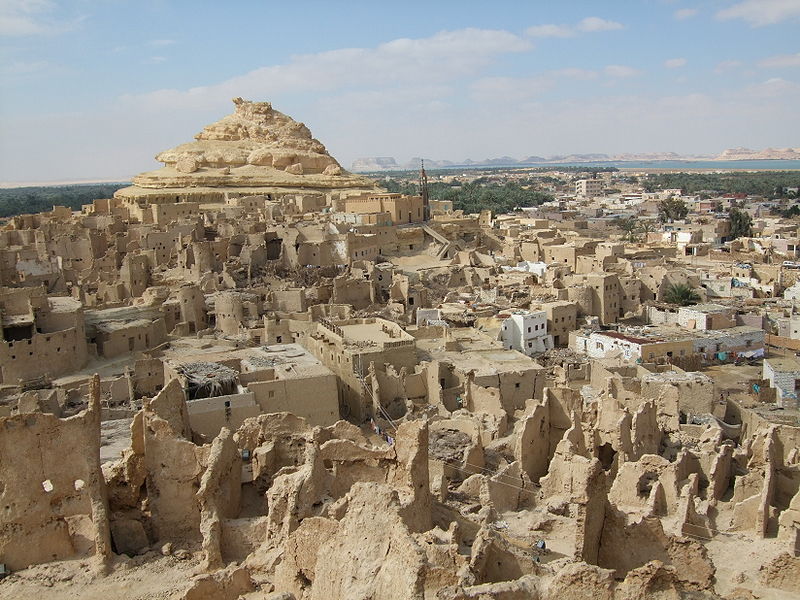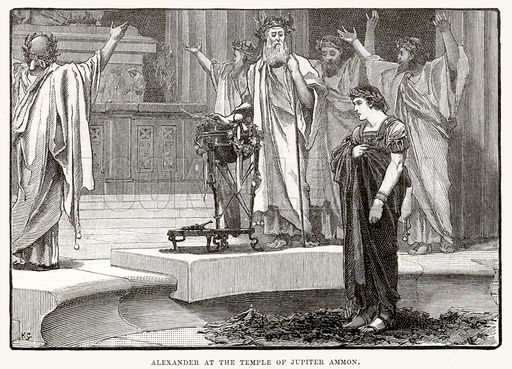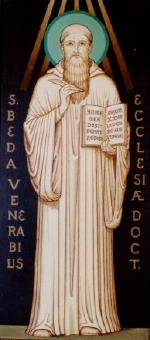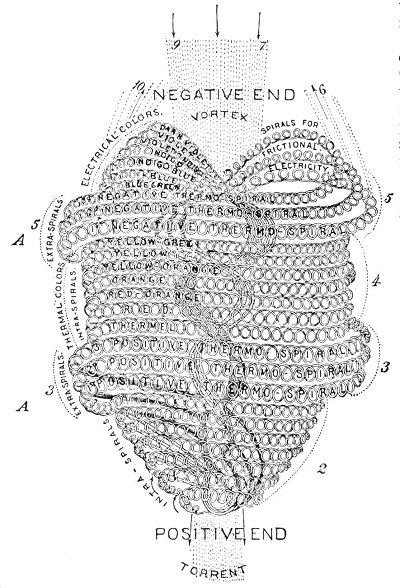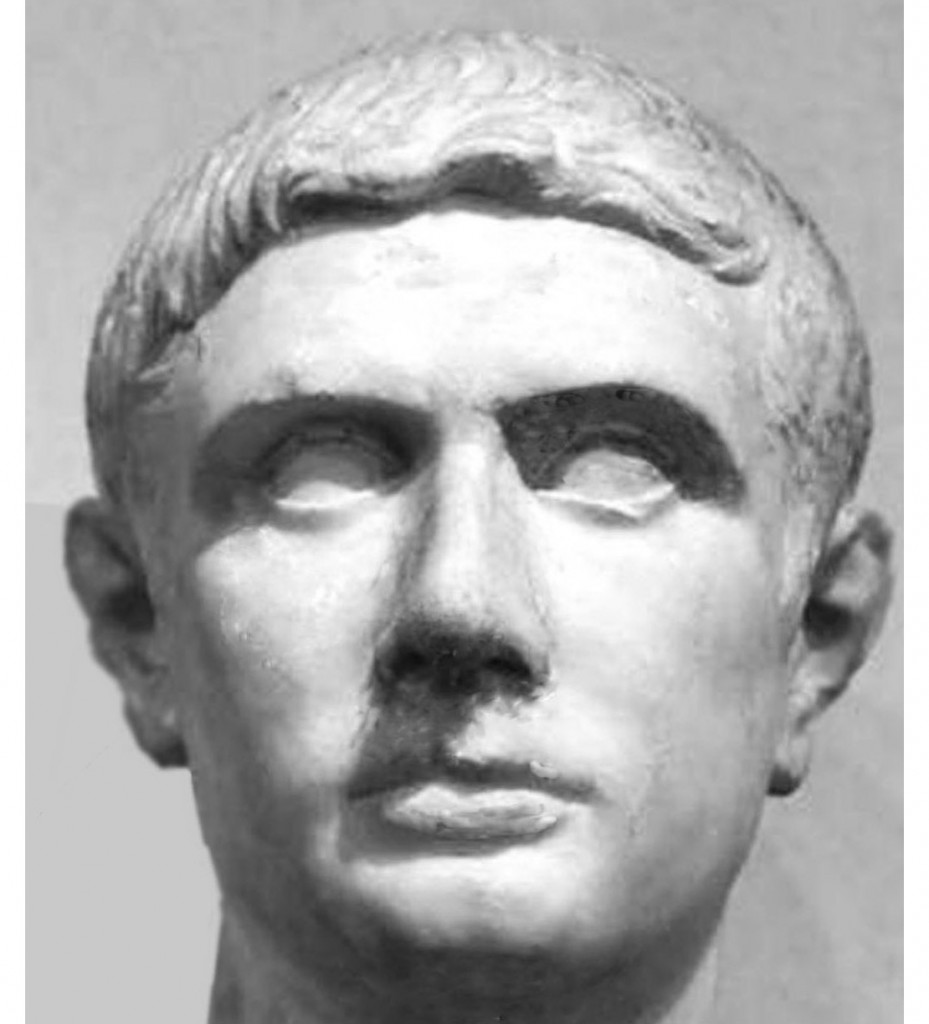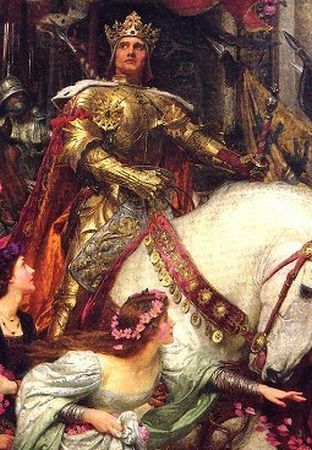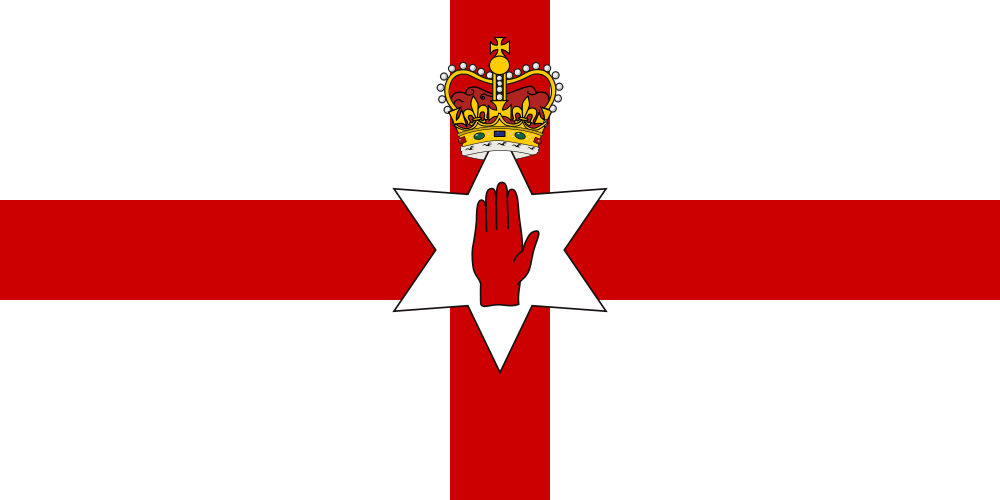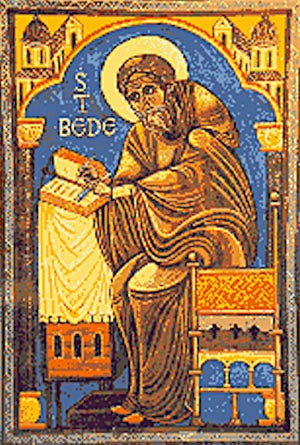 In studying my family history I have come across a great ancestor who means a lot to me. Someone who I feel is speaking from my soul to clear our family name and also settle some confusion that may be the result of lost history or simply stolen rites.
In studying my family history I have come across a great ancestor who means a lot to me. Someone who I feel is speaking from my soul to clear our family name and also settle some confusion that may be the result of lost history or simply stolen rites.
As Saint John and the CIA says, “You shall know the truth, and the truth will make you free.” (John 8: 31-32)
The alleged name of the ancestor I am speaking of is “Saint Bede.”
However, based on my research, this was not his original name and my findings below will prove this simple reality to you all. My goal is to help clear his good name and also get to the bottom of the facts that appear to be buried beneath centuries of Catholic Church concealment. I am sure at one time this was done for good reason, but these days are long over and when the veil is being lifted in the Apocalyptic end days that we see now, we must shine the light on our true histories in order to give proper honor to our ancestors, Church Fathers and Saints who are owed nothing but the truth, their relics and their rites to be restored.
Anything less would be an abomination of their good names and the great work they have “completed.”
The name Saint Bede appears to be a 9th or 10th century invention by the Catholic Church in order to hide the Saint’s true identity. The reason I believe this was done was because the popularity of his true family name before and after Bede was born. This family was not just any ordinary royal family, they were the founders of Rome and Britain who not only had country’s named after them, but were also the alleged murderers of Julius Caesar. The same Holy Grail bloodline where we would get allegorical stories such as ‘Brut y Brenhined’ (Brutus oi Brittany), King Arthur and even possibly the Mark of Cain.
Saint Bede’s family is that of the ancient “Alban” (Albion, Albinus) or “Brutus.” “Albion; they called it as the land of Brutus, Britain; and the Trojan men after their lord called themselves Britons.“
This is simply where an ancient royal family from where the beautiful country Britain derives its name. In his Geographia, Ptolemy, writing in the 2nd Century AD, uses the name “Albion” instead of the Roman name Brittania. The reason being is that Britain was not called this name until much later date when around and before at least 930 AD it was called Albion. In 930, the English King Æthelstan used the title: rex et primicerius totius Albionis regni[6] (“King and chief of the whole realm of Albion”). His nephew King Edgar styled himself Totius Albionis imperator augustus (August emperor of all Albion) in 970.
This royal Albion or Albinus name you will find with common sense is better kept secret when you are attempting to Christianize the modern world rather than flaunting it as authors of English History, Doctors of the Church or Catholic Saints. It is much easier to say that the future Saint Bede was dropped off to a Monastery at age 7 by some unknown parents to live a pious life writing books and teaching 600 monks then to say that he was the son of powerful royal stock who enjoyed kingly privileges in the 7th and 8th centuries that had helped the Catholic Church achieve so much in so little time. In fact Bede would be the same man known as Alcuin who would be the Preceptor to Charlemagne and we can never have a pious Monk teaching a powerful French King also be known as the Father of English History and Doctor of the Catholic Church. ‘
This is the sole reason for the concealment of his true name of Albinus for the allegorical one of Beda or Bede which is actually an Egptian name for “white” and Albinus or Albus which is a Latin name for White. The original family of Beda were ancient Egyptian High Priests who had settled in Italy, Gaul, Britain, Ireland and Scotland in approximatley the 500 century B.C. They would later become the founder of Greece, Rome, Britain, Scotland and many other countries. Below and in this body of work in which this is the first part, I will provide you with my research to support the claims I have made above and to also support the information below.
The origin of the name is Old English and I have found that to be Baedae. When studying the ancient lineage of a name, you have to research various things in order to determine where the name may have originated. You do this by studying the name not only over ancient history, but also how he name may have changed over the centuries as the family moved to different countries or in some cases had to change the family name for security reasons.
As I stated above, the name Beda is actually an Egptian Arabic name for “white” where you will find the first use of it in written history the Siwa Oasis of Egypt
and associated with the Temple of Jupiter Ammon or Umm Beda where Alexander the Great was consecrated the “begotten” Son of Jupiter Ammon.
Here is a version of the name Beda in the Bible.
- Be-de’-ya (bedheydh, “servant of Yah”): A son of Bani who had married a “strange wife” (Ezra 10:35).
- From the descendants of Bani: Maadai, Amram, Uel Ezra 10:34
Here are the various fictitious names that I have found listed for the Saint:
- Baedae
- Baede
- Baedan
- Bedae
- Beda
- Bede
- Bedai
- Badaias
- Bedaw
- Bedan
- Acuin
- Alcuinous
This name I have found is truly rare and have only find it a handful of times in history, but each time this peculiar name seems to have a significant meaning. When a Church Father, Pope or even King takes on a certain name it is almost usually without a doubt that of an ancestor in honor of them. They just do not pick any old name out of a hat or leave it to chance. This I have found time and time again in studying ancient history. Many of the names that we know them as now are simply not the names they were known as of then. They had either taken on new names or they were changed sometime after their deaths for some reason. This is what had happened to Saint Bede because of his royal family.
Here are the various what I will call “Beda’s” throughout history that you will find all seem to be related to one another by the simple fact of the Catholic Church and you will find the name practically nowhere else in history.
- Bedais of Ptolemy
- Celtic or Germanic goddesses, Beda and Fimmilena
- King Beda of Lyndsey
- Beda and Mela, two sons of Porta who came into Britain, with two ships, at a place called Portsmouth in the year A.D. 501. They soon landed, and slew on the spot a young Briton of very high rank
- Beda Majob, a priest mentioned by Bede himself as present with St. Cuthbert at his death
- A monk contemporary with Charles the Great
- Baedan, King of Ireland
- Baedan Irish Saints
As you can clearly see, this is more than just a coincidence. Not only is this name very rare, it is tied to some pretty significant events in history and this is for a reason. Not only is the name rare and when you do find it, very famous names appear or events but also what I have found is the dates are all aligning with one another as to clearly indicate that this is indeed the same family of Albinus under the guise of Beda. Here are some example of these dates. that coincide with he names.
- A.D. 501. This year Porta and his two sons, Beda and Mela, came into Britain
- 589 Beda becomes King of Lyndsey
- Saint Bede was said to born in 675 AD and died in 735 AD (the same year Alcuin is born)
- Alcuin said to be born in 735 AD, but also was a student of Saint Bede who happened to die the same year Alcuin was born making this alleged story a true fabrication where just the dates prove falsities that CANNOT be denied
Then we have Bede, AKA Albinous magically appearing as the Preceptor to Charles the Great in approximately 735 AD.
The same date it is said that Bede had died in his cell in Wearmouth Jarrow. To alleviate all the confusion or discreencies, somewhere or at sometime it as decided that later his name would be changed from Albinus or Beda Junior to that of Alcuin to lesson the “magic” of Bede by distributing his good works for family security purposes to allegorical names. This Alcuin you will find was very celebrated as “The most learned man anywhere to be found” and so was Saint Bede as well. The peculiar thing that cannot be denied is where is Alcuin’s Tomb or Relics in relation to Saint Bede. In researching history you will find that Bede’s are held in high esteem to where historians have debates about his birth, death and where his tomb is truly located to that of Alcuin who seems to be the forgotten step child with no tomb or relics with very litte if any fan fare in regards to his death. For Alcuin to be said held in such high esteem, so we would he after his death and most certainly his relics. But that facts are that they are not because Alcuin is NOT Alcuin, but Bede and you cannot honor false relics or Tombs that are empty because that would be an abomination of our family’s name.
In John Giles translation of The Miscellaneous Works of Venerable Bede By Saint Bede, Giles states this in regards to the multiple Bede’s and confusion surrounding the Saint:
This is by no means an uncommon practice with critics to account for anachronisms and inconsistent statements recorded of celebrated men by supposing that there have been others who have borne the same name, and that the facts, hitherto attributed to one, are to be portioned out between two or more. It is not, therefore, to be expected that the history of a writer so famous as our Bede, which is so interwoven with uncertainty, should have escaped being treated in the same manner. Indeed it is certain from our historian’s own testimony that he had a namesake, his own contemporary, but somewhat earlier. This was a priest and monk of Lindisfarne, now Holy Island, who enjoyed familiar intercourse with St. Cuthbert, and was chosen to remain with him in his last illness on Fame island. He is mentioned as ‘major Beda presbyter’ by our author in the 37th chapter of his life of St. Cuthbert. His epitaph is found in Mabillon’s Analecta Vetera IV. p. 521. ed. Paris, 381, “from which,” says Gaehle, ” it appears that he died in the year 681.” This, however, cannot be correct, as he was present at the death-bed of St. Cuthbert, who died A.D. 687.
Another Bede, also a monk, is said to have been contemporary with Charlemagne. A notice of him will be found in Mabillon’s Acta Ben. Sec. IV. and in Itin. Italic, p. 144.
A fourth individual bearing this name lived in the sixteenth century, and distinguished himself for his hostility to Erasmus and Faber Stapulensis. See Fabric. Bibl. Lat. Med. et Inf. JEt. i. ii. 522.
It is with the second of these three, his namesakes, that our historian is supposed to be confounded. The following passage from Hector Boethius1 will explain the nature of the mistake. He says:
Italiam cum Albione de Bedae incunabilis contendere, asserentibus Italis ipsum, Genuas natum, ibi denique ultimam solvisse naturae necessitatem, sepulcrumque ejus in rei fidei hactenus eadem in civitate cunctis haberi venerabile Un decunque traxerit originem, et ubicunque mortuus fuerit, satis tamen constare ex ejus et aliorum scriptis, adolescentem eum in Italia, senem in Northumbria, frequentius inter piorum ccetum Melros (Abbatiae monachorumque ccenobii id nomen est in Scotorum agro, maxime piis et religioni devotis viris semper insignis) habitasse, versatumque esse. – 1 Hist. Scot. Paris. 1574. ix. 181.
Italy disputes with Albion for the birth of Bede: the Italians assert that he was born at Genoa, and also died there, and that even to this day his tomb is seen there, and is venerated by all However, wherever he was born and wherever he died, it is clear from his own writings and those of others, that he lived as a young man in Italy, and as an old man in Northumbria; generally at Melros (an abbey in Scotland), where there was a community of monks famous for piety and devotion.
A writer named Raphael of Volaterra2 also relates that the sepulchre of Bede was to be seen at Genoa, and, on the other hand, an earlier writer, Honorius of Autun (Augustodunensis), in his fourth book de Scriptoribus Ecclesiae, says that he died and was buried at Rome. There is indeed an account of his being buried in the church of the Vatican, found in Mabillon.
Requiescit etiam ante portam argenteam, sub rota scilicet porphyretica, ut a nostris majoribus accepimus, Venerabilis Presbyter Beda, qui fecit homilias: et ob ejus reverentiam antiqui nostri penitus non transibant per earn, nec nos transire permittebant.
The writers, from whom we have quoted the foregoing extracts, have probably all committed the error of confounding together the priest of Jarrow with the priest of Genoa, the contemporary of Charlemagne.
But what Hector Boethius says of Bede’s residence at Melros, in Scotland, seems to rest upon no foundation whatever, for, though Bede tells us that St. Cuthbert passed some time in that monastery for purposes of study, yet he nowhere hints at having resided there himself.
A similar notion, however, seems to have been entertained by Dempster, who, in his Historia Eccles. gentis Scotorum,4 has the following passage:
Bedam etsi omnes Anglum faciunt, reperis tamen, eum nee Anglum domo, nec Scotum, sed in Scotia diu vixisse, in Anglia diem supremum obiisse.
In order to complete this list of conflicting statements, it may be as well to add that two writers, Langen and Engelnusius,5 have not scrupled to say that Bede was born in Saxony in Germany.
The reason for the confusion is simply because these are all the same Beda who was actually supposed to be in his cold dark cell like a good ole pious English monk writing books in solitude and he was not supposed to be a Preceptor to a French King Solomon (Charlemagne) or Hiram (Bede) , the Grand Architect of the Temple who are the “key” players in the success of the world wide brotherhood. Facts like that are best kept secret when building the Temple, but now that we are ready for the cap stone, the veil must be lifted to reveal the true pillars of the Temple.
Clement and Albinus arrive to the court of Charlemagne:
The court of Charlemagne was crowded with Irish scholars, and a story told by a foreign chronicler of good authority, of the arrival of two distinguished Irishmen in France during the reign of that monarch, is peculiarly characteristic. The names of these two scholars were Clement and Albinus, and they arrived on the coast of France in company with a party of merchants. When they landed they saw crowds of Franks eagerly pressing round the merchants, as each proclaimed or exhibited his wares; and immediately, to draw attention to themselves, Clement and Albinus followed the example, and began to cry aloud, ” Who wants wisdom? Who wants wisdom? Let him come to us, for we have it to sell!” By continually repeating this cry, they soon attracted attention and became an object of curiosity, and an account of their behaviour having been given to Charlemagne, he sent for them to his court, was pleased with their manners and attainments, and placed Clement over a school he had established in France, while he sent Albinus to preside over a similar institution at Pavia. I will not attempt to enumerate the other learned Irishmen who flourished in France during the latter part of the eighth century and the beginning of the ninth, at which latter period Eric bishop oi Auxerre, in a panegyrical letter to the emperor Charles the Bold, speaks of Ireland as “despising the dangers of the sea, to migrate, with almost her whole troop of philosophers, to our coasts.”
The Old English name of “Beda, Bede or Baedae” I have found is not common in Catholic Church history as another version of this same said name but with an added “n” to the end of making it “Baedan.” Baedan (Baetan, Baithen, Boetan) and various versions of this same name are found in various Irish Saints located all over Ireland and Scotland before and also about the same time Saint Bede was said to have lived. The name is so unique that it simply cannot be discounted as a coincidence and with Bede also being a Doctor/Father/Saint makes this connection a divinely solid one that cannot be denied.
- BAEDA. [beda.]
- BAEDAN (BAETAN, BAOTAN) is probably only a different form of Baithen. Several saints appear under this name.
- (1) Baedan Mor, son of Lugaidh—Jan. 14. In Mart. Doneg. he is called “Abbot of Inis-mor A.D. 712:** in the same Martvrology, at Aug. 6, his mother’s name is given as Cainer, of Cluain-da-saileach, and the names of his brothers, who were saints, were Mochna (or Cronan). Lasrain, Garbhan, Baoithfn. Senchin, and Ruadhdn. Through his father he was come of the race of Cathaoir M6r, who is said to have reigned in Ireland from A.D. 120 to 122 (Mart. Doneg. by Todd and Reeves, pp. 15, 213; Four Masters, by O’Donovan, i. p. 102, n. *).
- (BAITHEN, a name of many forms and very frequent occurrence in Irish hagiologies. Colgan (Acta SS. p. 369, n. 3, and p. 437, n. l) gives also Baithin, Baoithin, Boethan, Baothan, with their Latin terminations; and others like Baedan, Buadan, &c. might have been added (see Reeves, Adamnan, pp. 49, 409). Many appear as mere names or with a simple designation, but others have a history, more or less distinct: such as—
- (1) Son of Alia, ofCluain-de-an in Down—Oct. 6. He is believed to have flourished at the close of the 6th century, as he is always mentioned in company with other three Baithens, who were connected with St. Columba, or lived about the same time (Colgan, Acta SS. p. 369, n.2; Lanigan, Feci, ffist. Ir. ii. p. 413). He is perhaps the Baithen commemorated at Tech-baithin in Arteach (now Tibohine, co. Roscommon; lb. 370, n. 2l).
- (2) Son of Cuana, and given in Mart. Doneg. as 11 bp. of Tench-Baoithin in Airteach of Connacht, or in the West of Midhe.” Both Colgan (Acta SS. p. 370, n. 2I) and Lanigan (Keel. Hist. Tr. ii. p. 413) seem to prefer assigning him to Tech-Baithin in West Meath—Feb. 19. He was of the race of Enna Finn, son of Niall of the Nine Hostages (king of Ireland, A.D. 379-405; Todd’s St Patrick, p. 250; Mart. Done}, by Todd and Reeves, p. 53); and Kelly puts his residence near the hill of Usneach, Westmeath (Cat. Ir. Saints, p. 75). He flourished about 640, as he was a disciple of St. Columba and a contemporary of St. Mochoemocus, who died on 13th March, A.D. 655. Kellv, however, gives this Baithen’s date as about 592, and Colgan (Tr. Thaum. p. 470) about 620, and again (fnd. Chron. to Acta SS.) 593. It is said that when St. Columba saw him at the Synod of Drum-Ceatt he counted him the handsomest man in Ireland, and prophesied that his spiritual graces would equal his beauty of form: but in place of being elated St. Baithen in his humility prayed to the Giver of this beauty to withdraw it, and ever after he was known as “ban, i.e. candidus vel exsanguis” (Colgan, Acta SS. p. 369; Tr. Thaum. p. 434). He is supposed to have written the Irish acts of St. Columba (Colgan, Acta SS. 369; Tr. T/iaum. p. 470). He was revered in many churches, named after him Tech-Baithin, “The House of Baithen” (lb. Acta SS, p. 369), and is identified with the Bp. Baitanus addressed, among others, in the letter on the proper time of Easter and on the Pelagian heresy by Pope John IV. A.D. 640, as given in Bede, F. II. ii. 19; Colgan, Acta SS. p. 17, n. 11; Lanigan, Feci Hist. Ir. ii. p. 413).
- Baotan or Boetan Mac Ua Corbmaic, Abbot of Cluain-mic-Nois, A.D. 663 (Mart. Dow}. by Todd and Reeves, p. 61)—March 1. Mart. Tallaaht calls him *’ Baitanus Episc. Cluana” (Kelly, Cal. of Ir. Saints, p. rvii), and Colesn {Acta SS. p. 437) says he died bishop there in A.d. 663 (compare Tr. Thaum. p. 377, n. M). He was descended from an ancient Con naught family, and succeeded Aedlugh, son of Cam man, in 651, as Abbot of Clonmacnoise, which is now called also “The Seven Churches,” on the east bank of the Shannon in King’s county. Colgan {Acta &>”. p. 437) and Four Masters (by O’Donovan, at A.d. 663, p. 275) attach him by birth to the sept of Conmaicne-mara, i.e. the inhabitants of Connemara, or the barony of Ballynahinch in the northwest of the province of Galway.
- Baetan of Monu—March 23. Mart. Doneg. (by Todd and Reeves, p. 85) says: u This may be the Baetan, brother of Corbraac aod Eimhin, who are of the race of Eoghnn-mor, Sod of Oilioll Olum:” and Colgan (Acta SS. p. 728) gives on this day Boedan, Ab. of Killboedain, son of Eugenius, and one of the six brothers of St. Corbmac. According to this last account, he was the sixth son, and followed his eider brothers Corbmac and Diermit into the scene of their missionary labours in Lethconn or the northern half of Ireland. He afterwards took up his abode and built his church at Killboedain, afterwards called Killoscoba or Killoseda, in Ifelaradia, under the patronage of the three noble families of Cinel-Decil, Clann-Scoba, (Clann-Serlo), and Silmiridhin. At rirst they devoted houses and lands to St. Baithen, but the first-named family afterwards transferred their affections to St. Cuan and St. Colman, and at last the place was not only deserted but had its name changedSt. Baithen perhaps returned to his native province of Munster, and died Ab. of Moin (Moneosis) or Moanmore. He is supposed to have live! about the beginning of the sixth century. (See Colgan, Acta SS. p. 728, and at p. 751 sq., io his Life of St. Corbmac (March 26); Kelly, Qjl Ir. Snnts, p. 103. On Shilvodanor Kill-boedaia, see Reeves, Eccl. Antiq. Ztotcn and Connor, pp. 302-3.)
- Son of Maonan, of Lannleire—June 18. Mart. Tallaght gives “Furodrain ocus Bait bin. and Mart. Doneg. has also this saint along with his brother Furadhran, Ab. of Lannleire, now the old church of Lyn, on the east side of Locgh Ennell, in the barony of Fartullagh, and co. Westmeath (Four Masters, by O’Donovan, i. &• 342, n. »).
- Baitan or Boetan of Cluain-an-Dobhair, which was situated somewhere in the present King’s County. Aengus and Marianus in their Festologies commemorate him on Dec, 1 ; and though he is come of the same Connemara family, ret he appears to be different from Baithen, son of Ua Corbmac (ut supra). Little, however, is known of him (Colgan, Acta SS. p. 437, n. 3). The Mart. Doneg. p. 335, identifies him with Mobaoi (Dec, 13) of Cluain-tionuabhair, or of Cluain-da-an-dobhair, in Ui-Muireadhaigh, the name of both their fathers being called Sinell; while Colgan {Acta SS. p. 598, c. 3, App.), in giving an account of the saints belonging to the house of Mochoemocus and race of Conmacus, mentions ‘* Beodan, who is also Mobecus, son of Sinell &c, Abbot of Cluain-dobhair, Dec. 13.”
- Baithonus, Bathanus, Bothanus, Bp.— Dec 25, A.d. 639. He is said by Camerarius (p. 203) to be connected with all Scotland, but specially with Shetland and Thule, and he may have been one of the five bishops addressed in the epistle of Pope John IV. A.d. 640 (while yet but pope elect) to the nation of the Scots, warning them to keep the true blaster and to avoid the errors of Pelagius (Bede, H. E. ii. c 19). But at the same time it may be mentioned that Colgan (Adt.SS. p, 17, n. “) identities the Baithanus in the epistle with St. Baithen, son of Cuanach, bp. of Tech-baithen, who flourished about A.D. 640 (see above, Baithen (2) and was a Scotic bishop in Hibernia, not Alba (see also Lanigan, Eccl. Hist. lr. ii. p. 413). In Berwickshire is the parish of Abbey of St. Bathans (N. S. A. “Berwickshire,’* p. 105; 0. 8. A. vol. xii. 61-64). The Register of the Priory of St. Andrews (p. 31), giving the taxation of the churches in the archdeaconry of the Lothians, assigns one mark to the ‘* Ecclcsia Sri. Boythani.” The parish of Gifford, or Yester, in East Lothian, was anciently called St. Bothans (-V. S. A. ” Berwickshire,” p.’ 105). The parish of Bowden is supposed also to take its name from this saint. “In the charter granted by King David 1. to the Abbey of Selkirk, mention is made of Bothenden, which seems to favour the conjecture of this parish being named after St. both an or Bodwin, and the site of this town w rtill pointed out near the village” (O. S. A. vol. xvi. p. 230). Perhaps Botnwell is called after him (0. 8. A. vol. xvi. p. 300). Ballebodan, or Kilbodan, in the parish of Ardchattan, tnav take its name from him, though the patron of the parish is St. Modan, but the m and b are interchangeable in Gaelic (Orig. Par, ii. pp. 148, 186). There is a Kilbedane in the lordship of Morven and Sheriffdom of Inverness {IbitL ii. p. 191). But Camerarius gives a St. Br>t nanus, bp. of Dunblane in Scotland at the 13th of January, though his reference does D«t exhibit the name (Bp. Forbes, Kal. of Scott. ^liata, p. 276). [A. P. F.]
As you can clearly see with the information and research I have provided that I have proven without a doubt that there has been a serious cover up of the name true name of Saint Bede which I have proven is actually a later allegorical invention to conceal the Saint’s true family name. This is only part 1 in this body of work about Saint Albinus . Please feel free to check back later for more of my work or you can sign up to my RSS feed here for email updates.

Moe is the founder of GnosticWarrior.com. He is a father, husband, author, martial arts black belt, and an expert in Gnosticism, the occult, and esotericism.

